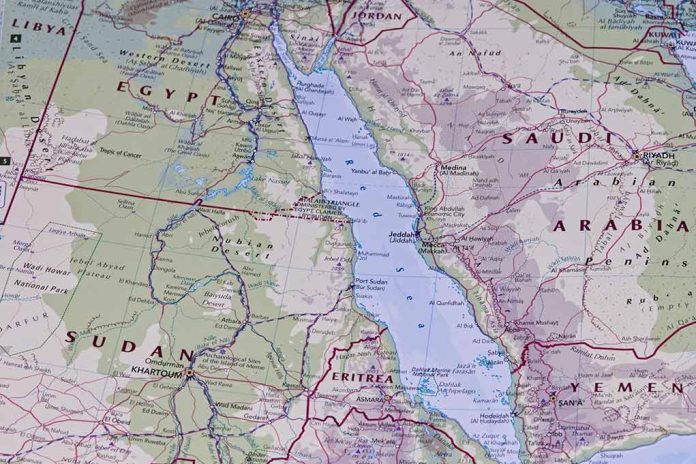
Trump’s military campaign against Yemen’s Houthi rebels has cost taxpayers over $1 billion, with thousands of bombs and missiles expended, yet resulted in a controversial ceasefire deal that allows Houthis to continue targeting Israel and other nations.
Key Takeaways
- Operation Rough Rider against Houthi rebels cost over $1 billion in just two months, including approximately 2,000 bombs and missiles worth at least $775 million.
- Despite the massive expenditure, Houthis have continued launching attacks, including against Israel’s main international airport.
- President Trump recently announced a ceasefire deal with the Houthis that only protects U.S. ships while allowing attacks against Israel and other nations to continue.
- The operation lost seven U.S. drones and two fighter jets, with additional costs for relocating Patriot missile defense systems to the region.
- Critics question the effectiveness of the campaign and the long-term strategic value of the ceasefire agreement.
Billion-Dollar Military Campaign Shows Limited Results
President Trump’s military operation against Houthi rebels in Yemen has racked up costs exceeding $1 billion since its launch in March. The operation, codenamed “Rough Rider,” deployed approximately 2,000 bombs and missiles against Houthi targets throughout Yemen in an attempt to degrade their military capabilities and protect shipping lanes in the Red Sea. The arsenal included hundreds of 2,000-pound bombs costing $85,000 each, at least 75 Tomahawk missiles at $1.9 million apiece, and approximately 20 AGM 158 cruise missiles valued at $1.5 million each. Despite this substantial investment, the Houthis have demonstrated resilience and continued to launch attacks.
Military analysts note that the operation has also cost the U.S. seven drones and two fighter jets, representing significant material losses beyond the cost of munitions. Additionally, the Pentagon spent at least $10 million relocating two Patriot missile defense systems to the region, not including the substantial air transport costs associated with this deployment. These expenses highlight the often-overlooked logistical costs of maintaining military operations in distant regions, even when the direct combat engagement remains relatively limited compared to larger-scale conflicts.
#US war on #AnsarAllah cost more than $1 BILLION since last March – #NBC https://t.co/NdjeEzxfht #Yemen
President Donald #Trump’s fight against the Al-Houthis never dealt a crippling blow to the group, but it has cost America more than $1 billion since March, including the… pic.twitter.com/vpCb2F04Ej— ⚡️🌎 World News 🌐⚡️ (@ferozwala) May 8, 2025
Trump’s Controversial Ceasefire Deal
President Trump recently announced a ceasefire agreement with the Houthi rebels, brokered partly through the Omani government. The deal suspends U.S. military strikes against Houthi targets in exchange for the group halting attacks on American vessels in the region. However, the agreement has drawn criticism for its limited scope, as it does not prevent the Houthis from continuing to target Israeli interests or commercial shipping from other nations. This selective protection has raised concerns about the strategic value of the arrangement and whether it truly addresses the broader regional security concerns.
“The administration was clearly looking for an off-ramp for this campaign against the Houthis,” said one U.S. official.
Some defense officials have questioned the actual cost of the operation, suggesting the expenditure on munitions might be closer to $400 million rather than the $775 million reported by some sources. Despite these discrepancies, the billion-dollar price tag of the overall campaign remains largely unchallenged. The Trump administration has defended the operation as necessary to protect American interests and restore freedom of navigation in the crucial Red Sea shipping lanes, which had been increasingly threatened by Houthi attacks on international commercial vessels.
Strategic Questions and Long-Term Implications
Defense experts have expressed skepticism about the long-term viability of the Trump administration’s approach to the Houthi threat. The ceasefire agreement allows the U.S. to justify suspending costly military operations while claiming a diplomatic victory, but questions remain about whether it will have any meaningful impact on the Houthis’ disruptive capabilities in the strategically vital Red Sea region. Critics argue that without a comprehensive strategy addressing the root causes of the conflict, including Iranian support for the Houthis, temporary cessations of hostilities may provide only illusory benefits.
“Washington has little patience and a short attention span and was unlikely to commit the resources and high-level attention necessary to see this campaign through to a meaningful outcome,” said Dana Stroul.
The operation against the Houthis began under the Biden administration but was significantly intensified after President Trump ordered expanded military action on March 15. Internal divisions within the administration regarding the extent and duration of the campaign have reportedly complicated efforts to develop a coherent long-term strategy. If the Houthis adhere to the limited terms of the ceasefire, the Trump administration may claim success in protecting American interests, but the broader goal of securing the Red Sea for all international shipping remains elusive as long as the group maintains its operational capabilities.
Taxpayer Burden and Budget Implications
The billion-dollar price tag for Operation Rough Rider raises important questions about military spending priorities at a time of significant fiscal constraints. With increasing demands for government spending on domestic priorities and border security, the substantial costs of overseas military operations attract greater scrutiny from fiscal conservatives. The massive expenditure on a campaign that ultimately resulted in a limited ceasefire rather than a decisive strategic victory exemplifies the challenges of balancing military objectives with fiscal responsibility in complex regional conflicts where American interests are important but not necessarily vital.
“The Houthis will stop shooting at U.S. ships for some period of time,” said Dana Stroul, highlighting the limited nature of the agreement.
As the Trump administration continues to assess its approach to regional conflicts in the Middle East, the Yemen operation serves as a case study in the challenges of achieving meaningful security outcomes through limited military interventions. The billion-dollar campaign demonstrates both the high costs of modern military operations and the difficulty of translating tactical successes into strategic advantages when dealing with determined non-state actors supported by hostile regional powers. Moving forward, the administration faces the challenging task of determining how to protect American interests in the region without becoming entangled in costly, open-ended military commitments.









